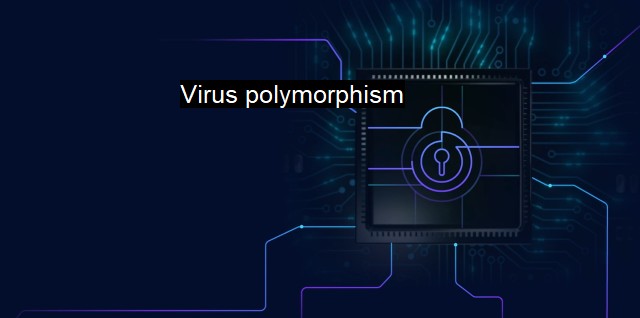What is Virus polymorphism?
The Risks of Virus Polymorphism: Adaptable Malware That Evades Detection Techniques in the Cybersecurity Landscape
Virus polymorphism refers to the ability of a computer virus to either mask itself by altering its code to appear non-identical on each infection or mimic common data types to deter recognition and elude elimination tools within a system, particularly anti-virus programs. Especially integral to the realm of cybersecurity, this capability to change form and behavior to subvert detection and analysis presents a serious challenge in defending against malware intrusions.A computer virus traditionally infects a device by embedding its malicious code into executable files, documents, or system registry. Where traditional viruses are relatively easier to detect and neutralize based on their static signatures, polymorphic viruses take a more deceptive approach. Every time they infect, they adapt their signature, fundamentally controlling internal departures and disguising their operative payload to bypass security software.
Broadly speaking, polymorphism involves two primary components: the encoded malicious code or payload that causes harm to the device, and the encryption engine, which encapsulates the payload and morphs it into different forms with each replication while keeping the virus's behavior constant. Owing to the same encryption engine, polymorphic viruses can carry an almost infinite number of permutations of their base code, making it daunting for antivirus software to pick up patterns and recognize threats precisely.
Polymorphic viruses exhibit intricate coding expertise and are designed to prevent traditional signature-based antivirus programs from detecting their presence. In other words, polymorphic malware removal becomes highly complex due to the diverse variants of the virus which go unnoticed by standard hash or string-based detection methods. Polymorphic threats strategically change their fundamental binary patterns and update their disassembly and reconstruction codes which enable them to evade traditional uni-dimensional, signature-based detection tools.
From an operational perspective, upon entering, the polymorphic virus scans the system for defense mechanisms. Simultaneously, it releases an entirely new morphed version that the static-code detection by antivirus software fails to detect while replicating exponentially, thus compromising an entire network before a threat is ever identified.
This consistent metamorphosis brought about by polymorphism also makes it incredibly tough for professionals in cybersecurity to study the virus, thus forestalling virus analysis and reverse-engineering attempts aimed at understanding its behavior and formulating corresponding antidotes. polymorphic viruses can mutate their encryption techniques either by adopting different encryption algorithms or by changing the cryptographic key each time. Consequently, even heuristic analysis is rendered ineffective against such sophisticated threats.
One resolute measure to counter polymorphic threats is the use of behavioral analysis that studies the actions and potential impact of a program rather than viral code signatures. Advances in machine learning and artificial intelligence have abetted developments in behavioral detection methodologies, which can monitor system cues such as file modifications or unexpected system interactions, flagging such activities as suspicious. a strong security stance mentioning effective patching and updating of antivirus libraries, firewall and intrusion preventive system configurations, and user rights management can also aid in softening the vulnerability edges.
While polymorphic viruses shall continue to pose significant security challenges, consistent efforts must be undertaken to update and strengthen anti-virus software to protect systems against existing viruses and their emerging versions. Lastly, taking cognizance of these threats and understanding their modus operandi while coupled with proactive system governance and user education shall indeed escalate protective layers, alleviating security threats posed by virus polymorphism.

Virus polymorphism FAQs
What is virus polymorphism?
Virus polymorphism is a technique used by malware creators to evade antivirus detection. It refers to the ability of a virus to continually evolve and change its code, making it difficult for antivirus programs to recognize and eliminate.How does virus polymorphism work?
Virus polymorphism works by making small, random changes to the code of a virus each time it replicates. This means that each iteration of the virus is slightly different, making it difficult for antivirus programs to detect and eliminate.What can be done to combat virus polymorphism?
To combat virus polymorphism, antivirus programs use a variety of techniques such as behavioral analysis, heuristics, and signature-based detection. These techniques allow the antivirus software to recognize and eliminate viruses even if they have undergone some level of mutation through polymorphism.Are there any other ways to protect against virus polymorphism?
Yes, other ways to protect against virus polymorphism include keeping antivirus software up-to-date with the latest definitions, avoiding suspicious links and downloads, and implementing strong cybersecurity measures such as firewalls and intrusion detection systems. Additionally, practicing safe browsing habits and being cautious of unknown email attachments can help protect against all forms of malware, including those that use virus polymorphism.| | A | | | B | | | C | | | D | | | E | | | F | | | G | | | H | | | I | | | J | | | K | | | L | | | M | |
| | N | | | O | | | P | | | Q | | | R | | | S | | | T | | | U | | | V | | | W | | | X | | | Y | | | Z | |
| | 1 | | | 2 | | | 3 | | | 4 | | | 7 | | | 8 | | |||||||